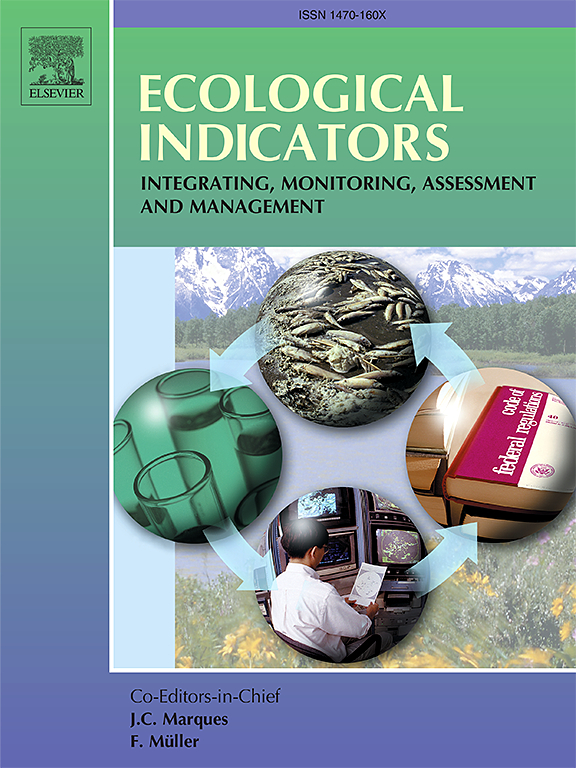The effect of soil chemical properties and ecological implications on the distribution of heavy metals in different types of peatland
IF 7
2区 环境科学与生态学
Q1 ENVIRONMENTAL SCIENCES
引用次数: 0
Abstract
Due to their sorption properties and high organic matter content, peatlands play an important role in the retention of pollutants, including heavy metals. This study aimed to assess the extent and level of heavy metal contamination in different types of histosols (fibric, hemic and sapric) found Polish peatlands. It was hipothesised that differences in peatland type, reflected in the degree of organic matter decomposition and chemical composition, would significantly influence the accumulation levels and geochemical behaviour of heavy metals. The study examined the chemical properties and heavy metal content of three peatland soil types across 277 systematically distributed sampling plots in Poland. From each plot, composite soil samples were collected at a depth of 0–15 cm and analysed for pH, total carbon and nitrogen, and exchangeable cations (Ca2+, Mg2+, K+, Na+), and heavy metals (Cd, Co, Cr, Cu, Ni, Pb, Zn) using standardised laboratory procedures. The geo-accumulation index (Igeo) was applied to assess pollution intensity relative to regional geochemical backgrounds. Multivariate statistical techniques and spatial analysis were employed to identify patterns in soil chemistry and contamination. The results revealed significant differences in chemical properties between peatland types. Fibric histosols exhibited the lowest pH and the highest organic carbon content and C/N ratio, indicating a lower degree of decomposition. In contrast, sapric histosols exhibited a higher pH value, elevated levels of base cations (particularly Ca2+ and Mg2+), and more advanced organic matter mineralisation. Concentrations of heavy metals (especially Cd, Cr, Cu, Ni, and Zn) were generally highest in sapric histosols, particularly in southern Poland. The geo-accumulation index (Igeo) showed that sapric histosols were more contaminated than fibric and hemic types, with the highest Igeo values observed for cadmium and chromium. Spatial analysis revealed that the most polluted areas, as defined by the Igeo classification, were concentrated in the industrialised southern and south-western regions of Poland. These findings confirm that both natural and anthropogenic heavy metal accumulation are strongly influenced by peatland type and location. Statistical analysis showed strong correlations between metal content and pH, as well as cation concentrations (Ca2+, Mg2+, K+ and Na+). The distinctiveness of the chemical and metal composition of different peatland types highlights the importance of considering soil type and parameters when assessing environmental risk. This study provides new insights into the distribution of heavy metals in Polish peatlands and their association with histosol type and soil chemical properties. It demonstrates that the peatland type significantly influences the accumulation and spatial distribution of heavy metals in soil, with sapric histosols showing the highest levels of contamination. These results emphasise the significance of peat decomposition stage, pH and base cation content in determining heavy metal retention.
不同类型泥炭地土壤化学性质及生态意义对重金属分布的影响
由于泥炭地的吸附特性和高有机质含量,泥炭地在保留包括重金属在内的污染物方面发挥着重要作用。本研究旨在评估波兰泥炭地发现的不同类型组织(纤维、化学和辛辣)中重金属污染的程度和水平。据推测,泥炭地类型的差异(反映在有机物分解和化学成分的程度上)将显著影响重金属的积累水平和地球化学行为。该研究检查了波兰277个系统分布的采样地块中三种泥炭地土壤类型的化学性质和重金属含量。从每个地块中,在0-15 cm的深度收集复合土壤样品,并使用标准化的实验室程序分析pH值、总碳和总氮、交换阳离子(Ca2+、Mg2+、K+、Na+)和重金属(Cd、Co、Cr、Cu、Ni、Pb、Zn)。应用地质积累指数(Igeo)评价区域地球化学背景下的污染强度。采用多元统计技术和空间分析方法确定土壤化学和污染的模式。结果表明,不同泥炭地的化学性质存在显著差异。纤维组织溶胶的pH值最低,有机碳含量和碳氮比最高,表明其分解程度较低。相比之下,讽刺组织sol表现出更高的pH值,碱性阳离子水平升高(特别是Ca2+和Mg2+),以及更先进的有机质矿化。重金属(特别是Cd、Cr、Cu、Ni和Zn)的浓度通常在讽刺组织中最高,特别是在波兰南部。土壤累积指数(Igeo)显示,含盐组织土壤污染程度高于纤维型和半纤维型,其中镉和铬的Igeo值最高。空间分析显示,根据Igeo分类,污染最严重的地区集中在波兰的工业化南部和西南部地区。这些发现证实了自然和人为的重金属积累都受到泥炭地类型和位置的强烈影响。统计分析表明,金属含量与pH、阳离子浓度(Ca2+、Mg2+、K+和Na+)有较强的相关性。不同泥炭地类型的化学和金属组成的独特性突出了在评估环境风险时考虑土壤类型和参数的重要性。该研究为重金属在波兰泥炭地的分布及其与组织溶胶类型和土壤化学性质的关系提供了新的见解。结果表明,泥炭地类型对土壤重金属的富集和空间分布有显著影响,其中以泥炭土污染程度最高。这些结果强调了泥炭分解阶段、pH和碱阳离子含量对重金属滞留的影响。
本文章由计算机程序翻译,如有差异,请以英文原文为准。
求助全文
约1分钟内获得全文
求助全文
来源期刊

Ecological Indicators
环境科学-环境科学
CiteScore
11.80
自引率
8.70%
发文量
1163
审稿时长
78 days
期刊介绍:
The ultimate aim of Ecological Indicators is to integrate the monitoring and assessment of ecological and environmental indicators with management practices. The journal provides a forum for the discussion of the applied scientific development and review of traditional indicator approaches as well as for theoretical, modelling and quantitative applications such as index development. Research into the following areas will be published.
• All aspects of ecological and environmental indicators and indices.
• New indicators, and new approaches and methods for indicator development, testing and use.
• Development and modelling of indices, e.g. application of indicator suites across multiple scales and resources.
• Analysis and research of resource, system- and scale-specific indicators.
• Methods for integration of social and other valuation metrics for the production of scientifically rigorous and politically-relevant assessments using indicator-based monitoring and assessment programs.
• How research indicators can be transformed into direct application for management purposes.
• Broader assessment objectives and methods, e.g. biodiversity, biological integrity, and sustainability, through the use of indicators.
• Resource-specific indicators such as landscape, agroecosystems, forests, wetlands, etc.
 求助内容:
求助内容: 应助结果提醒方式:
应助结果提醒方式:


